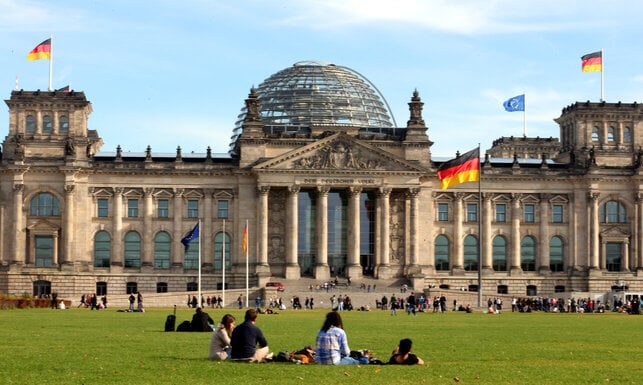In some countries around the world, flying the national flag is a source of joy, in others it is associated with far-right movements. Overall though, flags of nations can represent all sorts of things.
It’s fair to say that Germans have a complicated relationship with patriotism, and their flag.
Due to World War II and National Socialism, many people have struggled with their attitude to national symbols such as the German flag.
However, these feelings have eased in recent years and Germans have got more comfortable flying the flag, especially at sporting events.
So where does the flag come from, and what does it represent?
According to the German government, the exact origins of the black, red and gold colours are not certain.
What is clear is that the colours were used by the liberal national movement of the 19th century during a time when the question of German unity dominated the agenda.
READ ALSO: EXPLAINED: What I was asked about in my German citizenship test
“The patriotic German Students’ Association founded in Jena in 1818 chose these colours in the belief that they were the colours of the old empire,” says the government in an article on state symbols.
There is some debate over whether the red-trimmed black uniforms of the Lützow Free Corps from the wars of liberation (1813-1814) were part of this choice.

The tricolour featuring black, red and gold, was really established at the Hambach Festival back in 1832, which was a gathering of around 40,000 students and professors who supported liberalism and democracy and were against conservatism and censorship.
During the March revolution of 1848 the states of the German Confederation at that time designated a flag with the black, red and gold as the official federal colours. These colours were said to represent liberalism, democracy and coming together through a national movement.
But after the revolution failed to unify Germany, the flag also disappeared as a national symbol.
New flag colour surfaces
Another flag came about during the North German Confederation era from 1867 to1871. Chancellor Otto von Bismarck is said to have ordered the creation of a new black, white and red tricolour as the flag of the navy and the merchant marine. It was adopted as the national flag of the German Empire in 1892.
However, when the Weimar Republic was formed in 1918, the original flag colours of ‘Schwarz-Rot-Gold’ came back into action and was adopted as the national flag.
Black, red and gold were recognised as the Reich colours and enshrined as such in the constitution. The aim was to embrace values of democracy, republicanism and liberalism in a new era.
But a special carve-out was made for the merchant flag, which was allowed to remain black, white and red and have the Reich colours in the upper inside corner. “From this compromise it was clear that the issue of the flag was still unresolved and remained on the political agenda,” says the German government. “It developed into an ongoing dispute that even brought down the Reich government in 1926.”
When the Nazis came to power in the 1930s, the flag changed once again. In 1935, under the Reich Flag Act, the swastika flag was declared the national flag.
After World War II came to an end in 1945, the Federal Republic of Germany adopted the old colours of the flag from the 1848 revolution and the Weimar period. Black, red and gold came to be world renowned as Germany’s flag.
READ ALSO: Schwarz-Rot-Gold: A nation’s history in colour

According to the German government, a speaker in the Parliamentary Council said: “The tradition of black, red and gold is … unity in freedom. This flag should serve as a symbol to us that the libertarian idea of personal freedom should be one of the foundations of our future state.”
What happened when Germany was divided?
During the separation, East Germany kept the black, red and gold tricolours, but added the hammer and compasses emblem.
But after reunification, the black, red and gold tricolour once again represented unified Germany.
At midnight on October 3rd 1990, when the two countries united once against in the form of the Bundesrepublik, the flag was hoisted in front of the Reichstag building in Berlin.



 Please whitelist us to continue reading.
Please whitelist us to continue reading.
Member comments